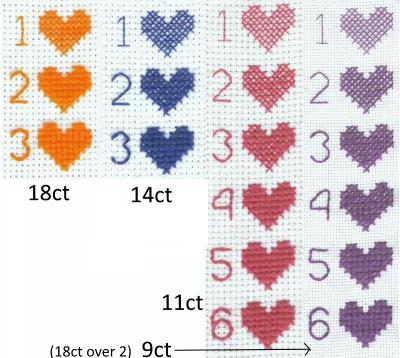Tips Blog
TIP - HOW MANY STRANDS
If you work on many of my designs (X's & Oh's, in case you forgot, LOL), you may have noticed that I generally use THREE STRANDS (commonly written as 3X) in my designs.
Some times I work with varying numbers of strands - one strand in the background, for a soft focus, or half-stitched for an even softer look, say for sky or horizon. Two strands - or even one strand full-stitched - is often the next layer... maybe trees, or mid-background; while the main focal points of the design are worked with three strands, so they stand out.
Three strands cover white or black fabric more completely than the usual two strands, but it also depends on the size of your stitches! So I would use three strands for 14ct, and maybe even 16ct, but on smaller fabric then that I would reduce to two strands.
Just a reminder that the fabric count refers to the number of stitches per inch (so 14ct would have 14 stitches per inch).
What I generally suggest is that you take a scrap of fabric, or use the corner of the project fabric where it won't be seen (for example, where it will be tucked behind the picture when it's framed), and test the varying number of strands so you can decide how many you want to use.
Here is a great chart I found on-line some time ago, showing the different strand usage on different fabric... a great reference tool (unfortunately I don't know who made it, or where I found it, if anyone knows, please let me know so I can credit the creator). Of course it would be simple to create your own similar reference tool, with smaller hearts, squares or diamonds:

So you can see what a difference additional strands can make, but as I mentioned above, the best way to see for yourself is to do small test areas, say 10 or 12 stitches wide / high. Do a square of 1X, then a square of 2X, and finally a square of 3X, so you can see how the coverage improves as you go.
Up till now we've talked about using 1-3 strands, but (as you can see from the chart above) there are times you may want to use 4, or even 6 strands - yes, really! If you're working on a very large count (like 9 or even 7), then you also have to increase the amount of floss you use to cover that larger area! Once again do a test to see how many strands you need to use for best coverage.
BTW, if you like to use a loop start, then keep the number of strands even - so for example, try 4 strands (2 strands doubled); as always, you can use the number of strands indicated in a design, or you can do some experimenting and decide what works best for you! If you don't remember how to do a Loop Start (or never heard of such a thing), be sure to check out our 07/2017 Tip Blog!
Happy stitching...